Links
Fay Marine Photographs 12
Pages 10, 11 & 12 contain detail pictures of subjects that I am often asked about.
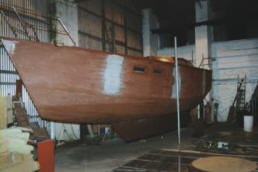
Do I use filler? Yes of course I do. It is nearly impossible to construct a steel hull without some distortion and even less possible to totally remove it. Therefore, some filling becomes almost inevitable.
I do not like to fill below the water line but sometimes when filling the vertical welds which always seems to be needed, it may be necessary to go just below the waterline with the filler. Above the waterline polyester filler seems to be fine (car body filler). Near to, or below the waterline, epoxy filler must be used.
When using epoxy filler, carefully follow the manufacturers recommendations. Some manufacturers prefer the steel to be painted with epoxy paint before the filler is applied and then the filler painted over, thus encapsulating the filler and ensuring that water can not reach the steel even if the outside paint is damaged.
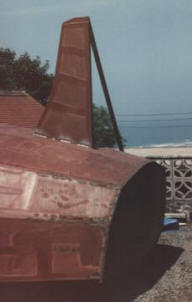
This is an example of a skeg being fitted. All the finish welding has been completed on the hull, so there should not be much more movement due to welding.
The skeg has been placed in position and a temporary brace holds it while it is welded to the hull. Once fitted a 'fillet' of steel, cut from 2" flat bar will be welded across the skeg to hull joint. This helps to spread the stress at this joint and combined with sensible interior web floors will ensure a strong construction. Once totally cold the brace can be removed.
This is not one of my designs and I consider this skeg to be less than the minimum for a true blue water yacht. It is great for fairly fast coastal cruising but a yacht with this type of design will need a strong crew when the wind blows hard.
For Mo and myself, being strong, but retired persons, with a lot of ocean miles behind us, we want something that ensures straighter tracking and a comfortable passage, even when it blows really hard. That is the reasoning behind the Fay designs. They are all long keel, directionally stable and fast. The only version with a skeg is the Fay 40 Twin keel, which has a large skeg and has already proved itself in strong winds.
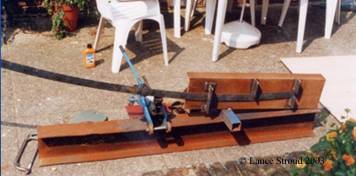
Bar bending for deck beams etc. is actually easy with the correct tool. The principles of both of these benders are obvious. They are easy to use and were constructed from inexpensive scrap steel. The hydraulic jack in the first picture was what the builder already had, but could also be a 'bottle jack' as used in the second picture.
The deck beams should be cut about 12" over long to allow them
to be bent to the end of the desired width. After bending they are trimmed to
the correct length. The radius for the deck beams should be set out on a surface
such as plywood. (perhaps the same plywood as the frames were set out on) If the
flat bar is marked
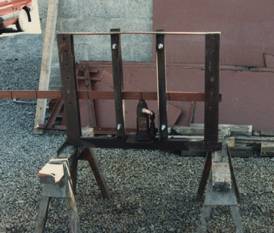 or drilled regularly (say 6" centres,
as in the picture) on what will be the
inner edge, then once in the bender and in position the jack can be given a set
amount of strokes at each point. It will quickly be found how many pumps of the
jack are needed to produce the needed bend. After a couple of attempts the
amount of pressure (strokes of the jack) will become evident and the rest will
progress quickly. Should the bar be bent too far it can simply be turned over
and the process reversed.
or drilled regularly (say 6" centres,
as in the picture) on what will be the
inner edge, then once in the bender and in position the jack can be given a set
amount of strokes at each point. It will quickly be found how many pumps of the
jack are needed to produce the needed bend. After a couple of attempts the
amount of pressure (strokes of the jack) will become evident and the rest will
progress quickly. Should the bar be bent too far it can simply be turned over
and the process reversed.
After bending the bar is laid on the marked curve to check that it is correct. It will easily be seen, where the curve of the beam separates from the drawn line and it will either need more bending or turning over and a little straightening to correct it.
The actual bending to the correct radius is easier than most people imagine. The one major problem is keeping the bar straight as it is bent. If all is kept in line this will not be a problem. If the bar starts to twist, stop and start again. Make sure it is straight, otherwise this will cause you problems later when the time comes to fit the deck plates.
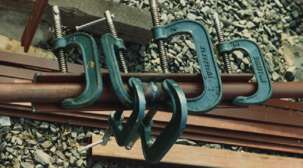
When joining a bar or tube, trying to keep it straight can be a problem. I overcome this by clamping the tube to a piece of angle as shown.
Around a quarter can be welded, allowed to go completly cold before turning , re-clamping and welding again. The weld will need grinding flat as you go to allow the tube to continue to sit tightly in the corner of the angle.
This may seem a little long winded but is well worth it and other jobs can be pursued while waiting for it to cool.
ŠPaul Fay 2004